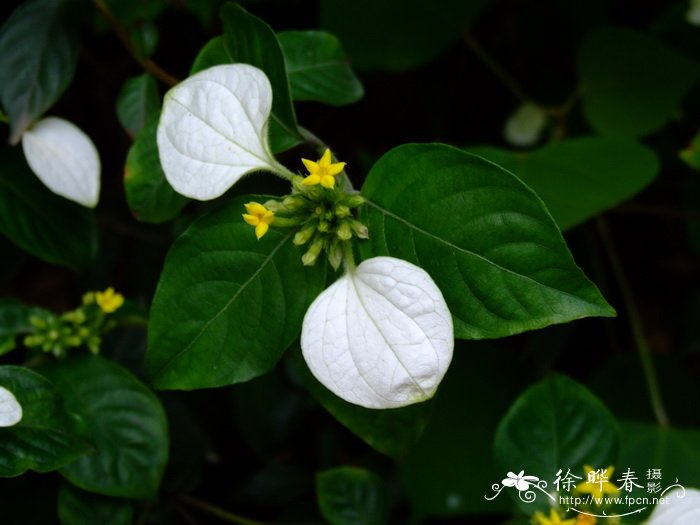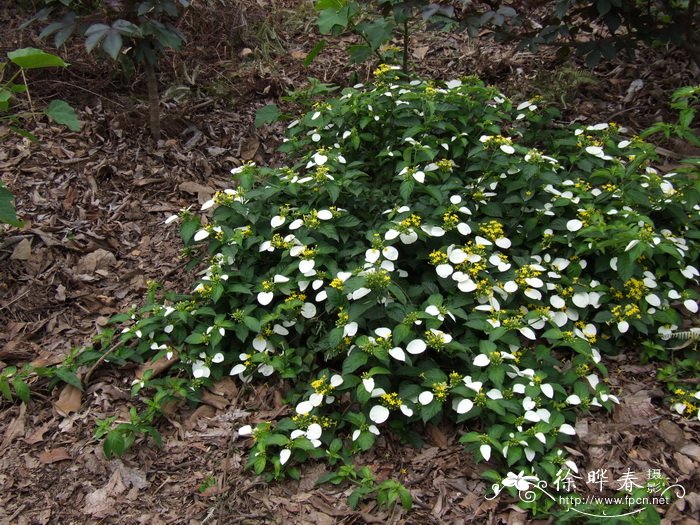玉叶金花Mussaenda pubescens
中文名(Chinese Name):玉叶金花
学名(Scientific Name):Mussaenda pubescens Dryand.
英文名(English Common Name):
别名(Chinese Common Name):野白纸扇
异名(Synonym):Mussaenda pubescens f. clematidiflora Chun ex Hsue et H. Wu Mussaenda bodinieri H. Lév. Mussaenda acutiflora Bartl. ex DC.
科属(Family & Genus):茜草科(Rubiaceae)玉叶金花属
形态特征(Description):攀援灌木,嫩枝被贴伏短柔毛。叶对生或轮生,膜质或薄纸质,卵状长圆形或卵状披针形,长5-8厘米,宽2-2.5厘米,顶端渐尖,基部楔形,上面近无毛或疏被毛,下面密被短柔毛;叶柄长3-8毫米,被柔毛;托叶三角形,长5-7毫米,深2裂,裂片钻形,长4-6毫米。聚伞花序顶生,密花;苞片线形,有硬毛,长约4毫米;花梗极短或无梗;花萼管陀螺形,长3-4毫米,被柔毛,萼裂片线形,通常比花萼管长2倍以上,基部密被柔毛,向上毛渐稀疏;花叶阔椭圆形,长2.5-5厘米,宽2-3.5厘米,有纵脉5-7条,顶端钝或短尖,基部狭窄,柄长1-2.8厘米,两面被柔毛;花冠黄色,花冠管长约2厘米,外面被贴伏短柔毛,内面喉部密被棒形毛,花冠裂片长圆状披针形,长约4毫米,渐尖,内面密生金黄色小疣突;花柱短,内藏。浆果近球形,长8-10毫米,直径6-7.5毫米,疏被柔毛,顶部有萼檐脱落后的环状疤痕,干时黑色,果柄长4-5毫米,疏被毛。花期6-7月。
分布(Distribution):产华南、福建、湖南、江西、浙江和台湾,生于灌丛、溪谷、山坡或村旁。
用途(Use):茎叶味甘、性凉,有清凉消暑、清热疏风的功效,供药用或晒干代茶叶饮用。
引自中国植物志英文版:FOC Vol. 19 Page 231, 232, 233, 240, 241
Mussaenda pubescens W. T. Aiton, Hort. Kew., ed. 2. 1: 372. 1810.
玉叶金花 yu ye jin hua| Rubiaceae | Mussaenda
Mussaenda bodinieri H. Léveillé & Vaniot; M. pubescens var. alba X. F. Deng & D. X. Zhang; M. pubescens f. clematidiflora Chun ex H. H. Hsue & H. Wu.
Climbing shrubs, often extensively twining; branches terete, densely strigillose and sometimes also villosulous, sometimes with congested groups of leaves borne on reduced axillary buds. Leaves opposite or perhaps rarely whorled; petiole 3-8 mm, moderately to densely strigillose; blade drying membranous or thinly papery, ovate-oblong, ovate-lanceolate, elliptic, lanceolate, or oblanceolate, 2-9 × 1-4 cm, adaxially sparsely strigillose to glabrescent on lamina and moderately to densely strigillose on veins, abaxially sparsely to densely strigillose with pubescence denser on veins, base acute to obtuse, apex acute to slightly acuminate; secondary veins 4-7 pairs, tertiary venation reticulate; stipules usually deciduous, triangular, 3-7 mm, moderately to densely strigillose, deeply 2-lobed, lobes narrowly triangular to subulate. Inflorescences terminal, subcapitate to congested-cymose, unbranched or sometimes tripartite, 1-3 × 1-3 cm, densely strigillose to villosulous, sessile to pedunculate; peduncles 0.1-1.4 cm; bracts linear, 3-5 mm; pedicels to 1 mm. Flowers sessile or infrequently pedicellate, biology not noted. Calyx moderately to densely strigillose to strigose; hypanthium portion ellipsoid to turbinate, 1.5-3 mm; lobes linear to narrowly triangular, 3-6 mm, with 1(or 5) lobes on 1-3 flowers per inflorescence of some plants expanded into white calycophyll, blade elliptic, broadly elliptic, ovate, or lanceolate, (0.4-)2.5-5 × (0.2-)2-3.5 cm, sparsely to moderately puberulent or strigillose on both surfaces, base acute to rounded, stipe 3-28 mm, apex obtuse to acute. Corolla white or yellow, salverform, outside moderately to densely strigillose or strigose; tube 11-20 mm, densely clavate pubescent in throat; lobes oblong-lanceolate to lanceolate, 2.5-4 mm, adaxially densely golden yellow papillose, acuminate. Berry subglobose, 8-10 × 6-7.5 mm, sparsely strigillose to glabrescent, smooth or finely lenticellate, calyx limb caducous, sometimes stipitate with stipe to 5 mm. Fl. Apr-Jul, fr. Jun-Dec.
Thickets in ravines, on hill slopes, or at village margins or roadsides; below 100-900 m. Fujian, Guangdong, Guangxi, Hainan, Hunan, Jiangxi, Taiwan, Zhejiang [Vietnam].
This species is widespread, common, and morphologically variable. H. H. Hsue and H. Wu (in FRPS 71(1): 296. 1999) described the leaf arrangement as opposite or whorled, but only opposite leaves have been seen on the numerous specimens studied.
One plant from Guangdong (Gaoyao) has all five of the calyx lobes petaloid and enlarged on each flower, though these structures are smaller than calycophylls that are borne singly on a flower. These plants have been separated as Mussaenda pubescens f. clematidiflora; this case was studied by Deng and Zhang (Acta Phytotax. Sin. 44: 611. 2006), who concluded that this plant is better regarded as developmentally abnormal and formally synonymized this name here. Plants with white corollas have been separated as M. pubescens var. alba; at least a third of the specimens of M. pubescens studied belong to this group, and considering that this color variation is common in other Rubiaceae species the variety is not recognized taxonomically here.


(责任编辑:徐晔春)
学名(Scientific Name):Mussaenda pubescens Dryand.
英文名(English Common Name):
别名(Chinese Common Name):野白纸扇
异名(Synonym):Mussaenda pubescens f. clematidiflora Chun ex Hsue et H. Wu Mussaenda bodinieri H. Lév. Mussaenda acutiflora Bartl. ex DC.
科属(Family & Genus):茜草科(Rubiaceae)玉叶金花属
形态特征(Description):攀援灌木,嫩枝被贴伏短柔毛。叶对生或轮生,膜质或薄纸质,卵状长圆形或卵状披针形,长5-8厘米,宽2-2.5厘米,顶端渐尖,基部楔形,上面近无毛或疏被毛,下面密被短柔毛;叶柄长3-8毫米,被柔毛;托叶三角形,长5-7毫米,深2裂,裂片钻形,长4-6毫米。聚伞花序顶生,密花;苞片线形,有硬毛,长约4毫米;花梗极短或无梗;花萼管陀螺形,长3-4毫米,被柔毛,萼裂片线形,通常比花萼管长2倍以上,基部密被柔毛,向上毛渐稀疏;花叶阔椭圆形,长2.5-5厘米,宽2-3.5厘米,有纵脉5-7条,顶端钝或短尖,基部狭窄,柄长1-2.8厘米,两面被柔毛;花冠黄色,花冠管长约2厘米,外面被贴伏短柔毛,内面喉部密被棒形毛,花冠裂片长圆状披针形,长约4毫米,渐尖,内面密生金黄色小疣突;花柱短,内藏。浆果近球形,长8-10毫米,直径6-7.5毫米,疏被柔毛,顶部有萼檐脱落后的环状疤痕,干时黑色,果柄长4-5毫米,疏被毛。花期6-7月。
分布(Distribution):产华南、福建、湖南、江西、浙江和台湾,生于灌丛、溪谷、山坡或村旁。
用途(Use):茎叶味甘、性凉,有清凉消暑、清热疏风的功效,供药用或晒干代茶叶饮用。
引自中国植物志英文版:FOC Vol. 19 Page 231, 232, 233, 240, 241
Mussaenda pubescens W. T. Aiton, Hort. Kew., ed. 2. 1: 372. 1810.
玉叶金花 yu ye jin hua| Rubiaceae | Mussaenda
Mussaenda bodinieri H. Léveillé & Vaniot; M. pubescens var. alba X. F. Deng & D. X. Zhang; M. pubescens f. clematidiflora Chun ex H. H. Hsue & H. Wu.
Climbing shrubs, often extensively twining; branches terete, densely strigillose and sometimes also villosulous, sometimes with congested groups of leaves borne on reduced axillary buds. Leaves opposite or perhaps rarely whorled; petiole 3-8 mm, moderately to densely strigillose; blade drying membranous or thinly papery, ovate-oblong, ovate-lanceolate, elliptic, lanceolate, or oblanceolate, 2-9 × 1-4 cm, adaxially sparsely strigillose to glabrescent on lamina and moderately to densely strigillose on veins, abaxially sparsely to densely strigillose with pubescence denser on veins, base acute to obtuse, apex acute to slightly acuminate; secondary veins 4-7 pairs, tertiary venation reticulate; stipules usually deciduous, triangular, 3-7 mm, moderately to densely strigillose, deeply 2-lobed, lobes narrowly triangular to subulate. Inflorescences terminal, subcapitate to congested-cymose, unbranched or sometimes tripartite, 1-3 × 1-3 cm, densely strigillose to villosulous, sessile to pedunculate; peduncles 0.1-1.4 cm; bracts linear, 3-5 mm; pedicels to 1 mm. Flowers sessile or infrequently pedicellate, biology not noted. Calyx moderately to densely strigillose to strigose; hypanthium portion ellipsoid to turbinate, 1.5-3 mm; lobes linear to narrowly triangular, 3-6 mm, with 1(or 5) lobes on 1-3 flowers per inflorescence of some plants expanded into white calycophyll, blade elliptic, broadly elliptic, ovate, or lanceolate, (0.4-)2.5-5 × (0.2-)2-3.5 cm, sparsely to moderately puberulent or strigillose on both surfaces, base acute to rounded, stipe 3-28 mm, apex obtuse to acute. Corolla white or yellow, salverform, outside moderately to densely strigillose or strigose; tube 11-20 mm, densely clavate pubescent in throat; lobes oblong-lanceolate to lanceolate, 2.5-4 mm, adaxially densely golden yellow papillose, acuminate. Berry subglobose, 8-10 × 6-7.5 mm, sparsely strigillose to glabrescent, smooth or finely lenticellate, calyx limb caducous, sometimes stipitate with stipe to 5 mm. Fl. Apr-Jul, fr. Jun-Dec.
Thickets in ravines, on hill slopes, or at village margins or roadsides; below 100-900 m. Fujian, Guangdong, Guangxi, Hainan, Hunan, Jiangxi, Taiwan, Zhejiang [Vietnam].
This species is widespread, common, and morphologically variable. H. H. Hsue and H. Wu (in FRPS 71(1): 296. 1999) described the leaf arrangement as opposite or whorled, but only opposite leaves have been seen on the numerous specimens studied.
One plant from Guangdong (Gaoyao) has all five of the calyx lobes petaloid and enlarged on each flower, though these structures are smaller than calycophylls that are borne singly on a flower. These plants have been separated as Mussaenda pubescens f. clematidiflora; this case was studied by Deng and Zhang (Acta Phytotax. Sin. 44: 611. 2006), who concluded that this plant is better regarded as developmentally abnormal and formally synonymized this name here. Plants with white corollas have been separated as M. pubescens var. alba; at least a third of the specimens of M. pubescens studied belong to this group, and considering that this color variation is common in other Rubiaceae species the variety is not recognized taxonomically here.
(责任编辑:徐晔春)
踩一下[1]

顶一下[4]